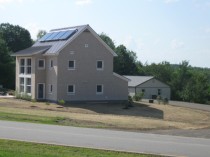By Stephen Mulkey, President, Unity College
Over the last decade, Unity College has made great strides in developing its sustainability portfolio by implementing numerous infrastructure projects and sustainable practices into our operations. Our former president, Mitchell Thomashow, did much to enhance our commitment to sustainability (see our remarkable 90 percent passive dorm, TerraHaus, and our net zero multipurpose facility, Unity House). Most recently, I have committed the College to participation as a founding member of the Billion Dollar Green Challenge developed by the Sustainable Endowments Institute, in partnership with the ACUPCC, Second Nature, AASHE, and others. The green revolving fund established through our participation will provide Unity College with a source of recurring dollars to fund sustainability projects over the long term.
Equally important to our infrastructure improvements is our institutional commitment to teaching sustainability. As an institution focused on environmental and natural resource sciences, we haverenewed our development of a curriculum focused onSustainability Science. All of these efforts have built on a much longer tradition of engagement with local and regional partners committed to sustainable resource use. Unity College has a long list of such partners including several conservation land trusts, the Maine Organic Farmers and Gardeners Association, and a variety of commercial and noncommercial entities concerned with food and energy sustainability.
I believe in the connection between our effectiveness as a regional anchor for sustainability scholarship and practice, and our increasing public support and expanding donor base. Our College Development office has weathered some lean times, but recently we have experienced a significant increase in donor activity, including a $10 million gift from an anonymous donor, which we announced in late August 2011.

TerraHaus at Unity College
Our explicit branding and activity as a place-centered environmental collegefocused on sustainability has leveraged our visibility to the philanthropic community. A significant component of this strategy has been our participation and leadership in the national ACUPCCnetwork — helping to build a critical mass of nearly 700 higher education institutions, committed to integrating sustainability into education, research and community engagement activities and pursuing net-zero greenhouse gas emissions from campus operations.
These efforts have made it much easier for the public to identify and understand our mission. For example, in the case of our recent large gift, Unity College was singled out for its commitment to students who are engaged with environmental issues relevant to Maine. Overall, the intentional creation of an explicit brand has sharpened and highlighted our identity among liberal arts colleges.
I have noticed reluctance on the part of some college and university leaders to attach themselves and their institution to sustainability and environmental issues as an identity for all or part of their institutions’ missions. Leaders sometimes fear that their institutions will be tarnished by the controversy or partisan affiliations sometimes associated with environmental issues, or by association with negative press regarding renewable energy (e.g., the recent Solyndra debacle) and climate change.
Our experience suggests that this fear and reluctance is misplaced. Our activism in support of climate change science and sustainability has energized a vibrant constituency, one that knows it is time to invest in higher education focused on the environmental imperatives of our time. By being clear about our goals we have drawn attention within the market that we serve. In short, our reputation for relevance is our greatest public relations asset.
Regardless of the opportunity to build support from a targeted constituency, there are compelling reasons for higher education to be out front on sustainability. The science is quite clear about current environmental trends. A child born today faces the prospect of living in a vastly diminished world unless we are able to make significant adjustments in our use of natural resources, and bring new sources of energy rapidly on line. It is likely that we have little more than a decade to vigorously begin the transition towards sustainability. Failure to do so risks profound and irrevocable consequences over a millennial time scale.
Institutions of higher education have an obligation to provide students with the tools to face sustainability challenges, and we should not be reticent about our dedication to this mission. Through the ACUPCC, we can leverage for far greater cumulative impact as a sector. To extent that we can speak clearly about environmental imperatives, we can also help to shape public opinion, and help to create appropriate demand for the educational opportunities we provide to our students.

Add new comment